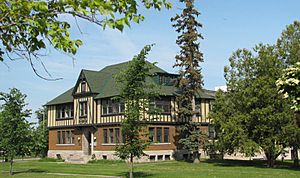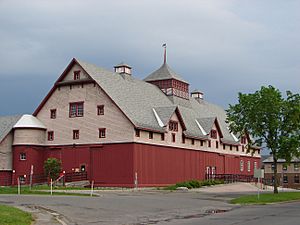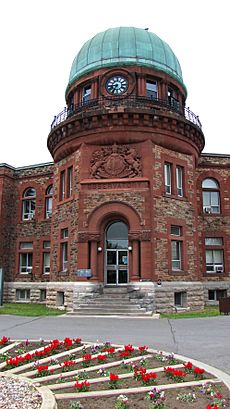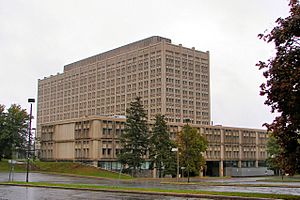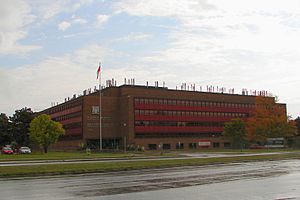Central Experimental Farm facts for kids
Quick facts for kids Central Experimental Farm |
|
|---|---|
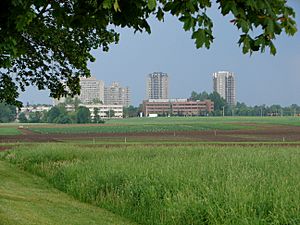
Central Experimental Farm
|
|
| Type | Agricultural facility, working farm, and research centre |
| Location | Ottawa, Ontario, Canada |
| Built | 1886 |
| Governing body | Agriculture and Agri-Food Canada |
| Website | Official website: http://www.agr.gc.ca/cef-fec/consultation/index.html |
| Designated | 1998 |
The Central Experimental Farm (CEF) is a special place in Ottawa, Ontario, Canada. It's a working farm, a research centre, and a beautiful park all in one! It's managed by Agriculture and Agri-Food Canada.
This large farm, about 4 square kilometers (1.5 sq mi), is located right in the middle of Ottawa. It's so important that it's been named a National Historic Site of Canada. Many of its buildings are protected because of their history.
The main goal of the CEF was to do scientific research. This research helps improve farming methods and crops. Today, it still does this important work. But it's also a popular spot for people in Ottawa to relax and learn.
Over the years, other groups have also built facilities on the farm's land. These include parts of Natural Resources Canada and National Defence. The Ottawa Civic Hospital even has a helicopter pad here.
The CEF is surrounded by important roads and landmarks. The Rideau Canal, another National Historic Site, is to its east. Other borders include Prince of Wales Drive, Baseline Road, Merivale and Fisher Roads, and Carling Avenue.
History of the Farm
In the late 1800s, many countries were very interested in science. They built zoos, observatories, and special farms for experiments. Canada wanted to do the same.
In 1886, a law was passed to create experimental stations. This happened thanks to John Carling, who was the Minister of Agriculture, and William Saunders, the first director of research.
The Central Experimental Farm started with 188 hectares (465 acres). It was chosen because it was close to Parliament Hill but still outside the city back then. Over the next few years, the land was prepared. Buildings were put up, and the Arboretum (a tree garden) was planted. Early research focused on insects, plants, and growing fruits and vegetables.
Many important government architects designed buildings at the CEF. These architects helped shape the look of many public buildings across Canada. Some used a style called Neo-Gothic, while others used Scottish baronial style.
In 1887-1888, buildings like the Museum, laboratories, and barns were designed. In 1889, farm animals were brought to the CEF.
Over time, the research at the farm grew. More land and buildings were needed. Some older houses were removed as the city grew around the farm. New, larger buildings were constructed, like the Saunders Building in 1935. Other important buildings like the Neatby Building followed.
During World War II (1940-1947), one building (Building 136) was used as a special Naval Radio Station. It helped connect Canadian naval headquarters with ships at sea. It also linked with other allied navies. A memorial was put up in 1993 to remember those who served there.
In 1983, the old Dairy Barn was turned into the Canada Agriculture Museum. This museum teaches visitors about farming history.
Many buildings at the CEF have been recognized as important heritage sites. This means they are protected because of their historical value. The Cereal Barn, the Main Dairy Barn, and the Botanical Laboratory are just a few examples.
In 1998, the entire Central Experimental Farm was officially named a National Historic Site.
In 2003, the head offices for Agriculture and Agri-Food Canada moved to a new building nearby. This building is called "NHCAP." The old main office building, the Sir John Carling Building, was taken down in 2014.
What You Can See and Do
The Central Experimental Farm has many interesting features for visitors. It's a great place to learn about farming, nature, and science.
- Dominion Observatory: This historic building was once used to study stars and planets.
- Canada Agriculture Museum: You can visit this museum to see farm animals and learn about Canadian farming history. It's located in the old Dairy Barn.
- Dominion Arboretum: This is a large collection of trees and shrubs. You can walk through beautiful gardens and see many different kinds of plants.
- Ornamental Gardens: These gardens are full of beautiful flowers and plants. They include:
- The perennial collection (plants that grow back every year)
- The rock garden
- The rose garden
- The annuals garden (plants that grow for one season)
- The Macoun Memorial Garden
- The hedge collection
- Fletcher Wildlife Garden: This garden is designed to attract local wildlife like birds and butterflies.
The farm also has important buildings where scientists do their research. These include the Eastern Cereal and Oilseed Research Centre (ECORC) and the K.W. Neatby Building.
See also
 In Spanish: Granja Experimental Central de Ottawa para niños
In Spanish: Granja Experimental Central de Ottawa para niños



